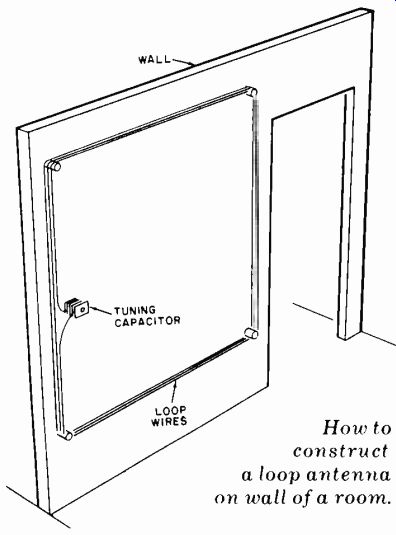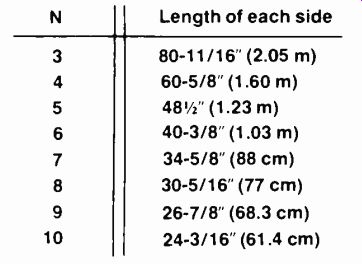BY DOUGLAS KOHL
Easy-to-build air-core loop helps pull in distant stations on inexpensive radios.

EVEN IF you're vacationing too far from home for normal AM reception, you can still pick up home-town broadcasts with an ordinary AM radio. Alternatively, if you're staying at home, you can receive out-of-town sports broadcasts to keep tabs on your favorite team. Using an inexpensive external loop antenna will do the trick. Here's why it works and how to build one.
Because portable and desktop AM receivers employ relatively small, internally mounted ferrite-core loop antennas, they can deliver only enough signal for good reception of local stations.
However, if an external loop with a larger effective cross-sectional area is substituted for the internal one, or used in tandem with it by mutual coupling, the working sensitivity of the receiver is increased in direct proportion to the ratio of the loop areas.

---------- How to construct a loop antenna on wall of a room.
If the loops are used in tandem, no connections or modifications to the receiver are necessary. Signals will be coupled to the small internal loop inductively when the two loops are placed in proximity to each other. If your home is of wood-frame construction and the walls do not have metal lath, you can mount the large loop on a wall or even conceal the loop behind it. The loop can then be a source of fun as a mystery spot where your neighbor's $5 transistor radio will work better than ever before!
Constructing a Loop. A typical large loop antenna is shown in the figure. It is made simply by winding a series of turns of wire on some supporting structure.
The loop is tuned by a variable capacitor connected across it. The antenna can be supported by wooden pegs inserted into the wall or by a free-standing wooden cross frame. Insulated copper wire, No. 20 or larger, should be used. Bell wire or even No. 14 house wire will yield excellent results. Such a loop can be concealed if other members of the family consider it unsightly.
Plan to make your loop square, or at most, slightly rectangular. This makes it easy to compute the area inside the loop. Construct your loop so that it is as large as possible. A 7-ft x 9-ft (2.1-x 2.7-m) loop, for example, is suitable if you have 8-ft (2.4-m) walls. If possible, mount the loop on a wall which is in line with the distant radio stations you want to receive. The antenna is most sensitive to signals parallel to the plane of the loop, and least sensitive to signals propagating in directions perpendicular to it (striking the antenna broadsides). To calculate how many turns of wire are needed, compute the area of the proposed loop and use the following formula: N = 242.3/ where N is the number of turns and A is the area in square inches (1 square inch = 6.45 cm^2). For example, suppose the planned loop will measure 6' 9" (2.1 m) on each side. Its area will be 6,561 square inches (4.2 m^2 or 42,330 cm^2) and the number of turns required will be three. For your convenience, here are the loop sizes corresponding to an integral number of turns:

N | Length of each side
3 80-11/16" (2.05 m)
4 60-5/8" (1.60 m)
5 481/2" (1.23 m)
6 40-3/8 (1.03 m)
7 34-5/8" (88 cm)
8 30-5/16" (77 cm)
9 26-7/8" (68.3 cm)
10 24-3/16" (61.4 cm)
-------------
Incidentally, you can make a small, portable loop on a wooden frame to take along on picnics, or on a boat. A loop two feet square (0.3716 m^2 or 3716 cm^2) will provide good results with a "pocket portable" receiver.
Connect the loop ends to each side of an ordinary air dielectric variable tuning capacitor (one loop end to the rotor plates and the other to the stator plates). The capacitor, which can be removed from a junked AM receiver or purchased new (or surplus), should have a maximum capacitance of at least 360 pF. Multisection capacitors can be wired in parallel to extend the loop's tuning range. Be sure to solder all connections using rosin core solder.
Using the Loop. A loop antenna will provide some improvement in reception of all stations, not just the one at the frequency to which it is tuned. However, for best results the loop should be resonated. Tune the receiver to the desired station's frequency and place it in the vicinity of the large loop. Orient the receiver so that its internal ferrite bar is perpendicular to the plane of the loop. Then rotate the shaft of the antenna's tuning capacitor until the signal peaks.
Enhanced reception will be experienced when the receiver is placed up to approximately one side dimension of the loop in front of, or behind the wall on which the loop is mounted. Experiment with the placement of the receiver to determine the location that gives best results. The closer the receiver is to the loop, the more signal coupled to the internal ferrite antenna. For casual listening, as opposed to chasing weak DX signals, the degree of coupling between the loop and the receiver will not be critical, thanks to the large measure of improvement the loop provides.
[ P-E Exp. 1982]
Also see: